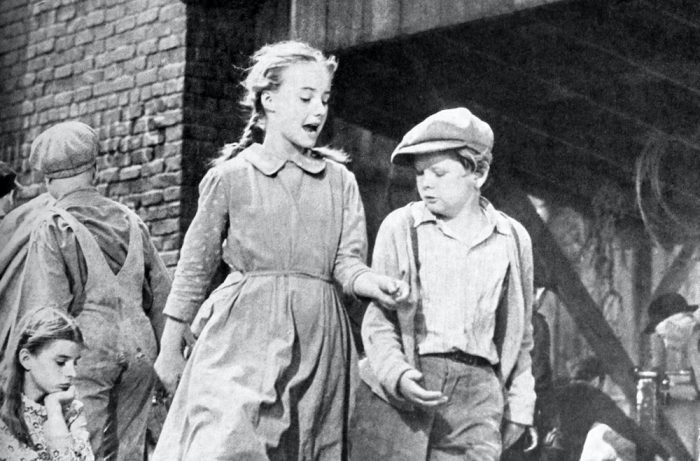Betty Smith’s Enduring Tribute to The American Dream

“Some people called it the Tree of Heaven. No matter where its seed fell, it made a tree which struggled to reach the sky. It grew in boarded up lots and out of neglected rubbish heaps and it was the only tree that grew out of cement. It grew lushly but only in the tenement districts.” This is the portrait which Betty Smith (née Elisabeth Lillian Wehner) paints of the Ailanthus altissima which grows in eleven year old Francie Nolan’s Williamsburg yard circa 1912 in Smith’s celebrated 1943 semi-autobiographical coming of age novel A Tree Grows in Brooklyn.
Francie and her brother Neeley are second generation Americans. Their father Johnny is a charming, good-looking Irish-American with a serious drinking problem. “Johnny is someone who would have done much better in the “Old Country,” novelist Spencer Baum said about Johnny in a 2018 article for Medium, “a land where a man’s role is carved out for him and strongly enforced by a rigid social structure. In the Old Country, a family like the Nolans could never escape their social station, but a man like Johnny would have never been allowed to deteriorate so completely either.”
Due to Johnny’s alcoholism and sporadic employment as a singing waiter, Francie’s mother Katie, a beautiful Austrian-American, works as a janitress to keep a roof over the family’s heads. The Tree of Heaven which “likes poor people” is the anchor of the novel. It represents not only Francie’s desire to rise above her impoverished background, but also symbolizes the American dream where ordinary people can elevate themselves out of cyclical poverty through hard work and education. A Tree Grows in Brooklyn was well received by both the public and the critics, selling 300,000 copies within six weeks of its initial release. The New York Times hailed Smith’s work as “A profoundly moving novel, and an honest and true one. It cuts right to the heart of life…If you miss A Tree Grows in Brooklyn you will deny yourself a rich experience.”
Smith’s novel is so punctuated with abject poverty, disease, alcoholism, social inequities and old-fashioned bad luck that it would be a very depressing story if it were not filtered through Francie’s prism. Francie, who reads a library book a day and two on Saturday, writes stories and dreams of being a writer. While Francie’s creativity and literary ambitions are her own, she is also highly influenced by her illiterate immigrant grandmother Mary who knew that acquiring an education was essential to upward mobility. Consequently, she insisted that Katie read aloud every night to Francie and Neeley from the King James Bible and The Complete Works of William Shakespeare. Like all children, Francie and Neeley play games and engage in imaginary scenarios. Their cultivation of the fantastic helps facilitate the notion of a bigger world outside of their Williamsburg tenement.
Education becomes Francie’s lodestar. However, her attendance at the local public school where three thousand students crowd into a space designed for a thousand is fraught with daily indignities and very little learning. “Teacher acted as though the [poor students] had no right to be in the school but that she was forced to accept them and was doing so with as little grace as possible. She begrudged them the few crumbs of learning she threw at them.” Francie at the age of eleven realizes that in order to be properly educated, she needs to change schools and tells her father that she wants to attend another school located just outside the Nolans’ immediate neighborhood. Using a false address, Johnny, in a gesture which may mark the earliest occurrence of school choice in literature, writes a letter to the principal notifying him that Francie needs a transfer as she would be residing with relatives at a house within the catchment area of the other school.
Francie would continue to undertake extraordinary measures to obtain an education. After Johnny’s death when money was even more scarce than usual, Katie decides to pull fourteen-year old Francie out of school to work. Francie assuages her disappointment by attending college classes during the day while working nights as a reader at a clipping service. Her voracious studying pays off when at age sixteen, she passes the Regents exams, obtaining admission to the University of Michigan despite never having attended high school.
I first read A Tree Grows in Brooklyn when I was twelve years old, as part of a summer reading requirement. I found the nearly 500-page novel to be so engaging that I read it three times before returning it to the library. I felt an instant kinship with Francie’s love of learning, feelings of insecurity and desire to make a difference in the world. As a child raised with the expectation that I would go to college and likely graduate school, I had a tremendous appreciation for the obstacles which Francie overcomes to pursue an education. I was also very touched by her unconditional love for her charming but flawed father.
A Tree Grows in Brooklyn, a runaway best-seller, was also released in an Armed Services edition and adapted for film, television, radio and Broadway. Nearly eight decades after its initial publication, the novel’s hopeful message about empowerment through education and hard work continues to attract new generations of adolescent and adult readers. As Anna Quindlen states in her introduction to the 75th anniversary edition, “This is not one of those social welfare novels in which the characters exist as marionettes, the strings jerked by the fashionable causes of their time… Instead it is that rare and enduring thing, a book in which, no matter what our backgrounds, we recognize ourselves.”
A Tree Grows in Brooklyn, has clearly stood the test of time, securing its place in the canon of America’s greatest 20th Century literature, and I remain as enraptured by it as when I was a rising seventh grader.
Comments